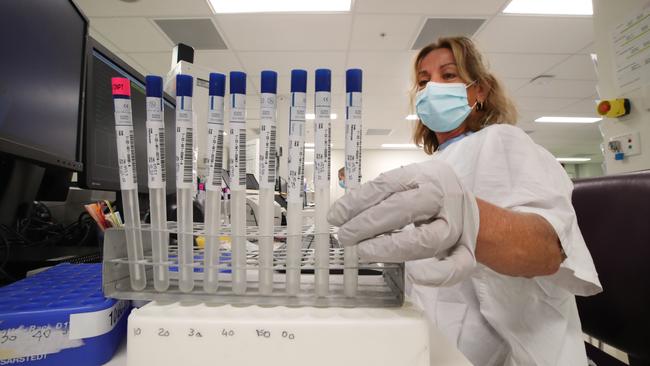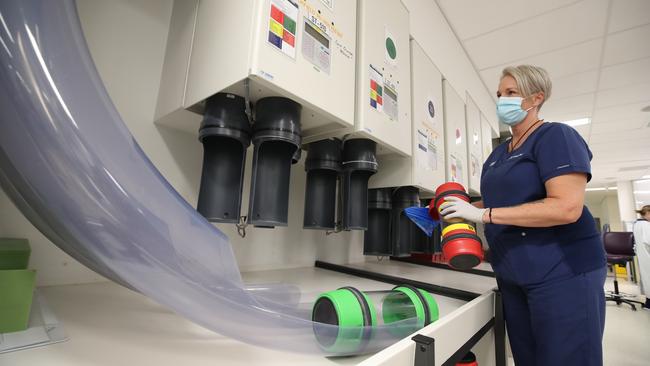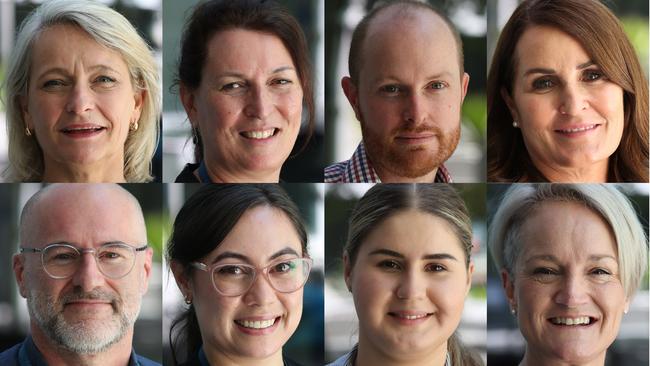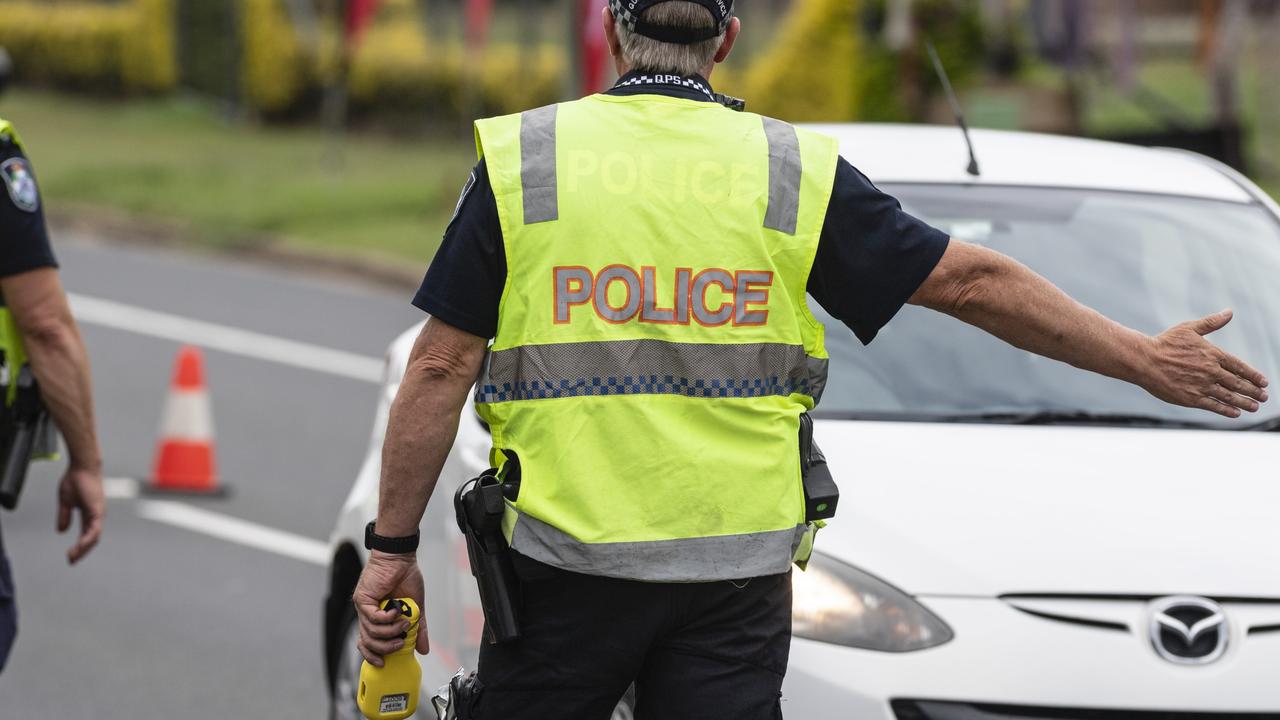How Gold Coast pathology team worked around the clock to help smash Covid
Hidden away behind the walls of a nondescript grey building is one of the most sophisticated operations on the Gold Coast. It has a life or death purpose – but hardly anyone knows it’s there. SEE INSIDE
Coronavirus
Don't miss out on the headlines from Coronavirus. Followed categories will be added to My News.
THERE is a grey, nondescript building at Gold Coast University Hospital.
At only three storeys tall, it makes no impact on the skyline. Its windows are blacked out. There is little to no signage.
Although it faces the main entrance and is beside the bustling public car park, almost nobody notices it’s there.
But for the last two months this has been one of the most important buildings on the Gold Coast.
This is the extraordinary story of the scientists and medical experts, the futuristic machinery and sophisticated laboratories, that by the dawn of 2022 had – unbeknown to most of us – become an indispensable part of our lives.
THE GATHERING STORM

Christmas Day 2021 was overcast in southeast Queensland. Grey clouds hung gloomily, threatening rain.
It wasn’t the only storm cloud gathering. Health Minister Yvette D’Ath appeared to deliver the government’s daily Covid update at a beach in Redcliffe, her sombre tone matching the sallow sky.
There were 765 new cases. The spread of Covid was escalating quickly. Just 10 days earlier the number recorded was six.
Amid Christmas celebrations, the news went unnoticed by many. But not by the pathology staff in that unassuming grey building at Gold Coast University Hospital. While most offices in the city were empty, this was a hive of activity.
“We had at least 30 people here on Christmas Day, and more people working remotely,” says acting group laboratory manager Shay Bosworth.
“People who wouldn’t normally be required to do that work but have remote access because of their role were suddenly helping, doing things that they wouldn’t normally do, because they could do it from home.”
The pathology staff – both those who collect Covid samples and the microbiology team who test them – knew what they had to do. For many, Christmas was cancelled.
“There were a few people who cancelled family Christmases,” says Shay. “Without being directed to, without being suggested to, they just knew it was the right thing to do.
“And holidays. People also cancelled their holidays.”
It was to be the start of a rough couple of weeks.
WHAT NO ONE KNEW

Plans were in place for a Covid wave on the Gold Coast. But not like this.
They had been drawn up based on the Delta variant. It was expected cases would rise steadily through the first months of the year, peaking in April. But by New Year’s Eve, daily case numbers were more than 3000. Omicron had changed the game.
“It was supposed to just be this gradual rise,” says Shay. “But it was almost like the wave hit before we even knew what happened. That was the effect of the Omicron variant.”
For Dean Gosling, who heads the microbiology team, the rapid rise required a rapid response.
“We got a troupe of casuals on board. We sourced everyone that we could from other departments. We had people working overtime. For example, I worked New Year’s Eve until 10 and was back at work at eight the next morning.
“As many hands as we could get from other departments, we took.
“We had anatomical biologists coming up an hour before their shift, knowing we were short staffed. They wanted to help the community and the health service.”
Clinical nurse consultant Sue Neil’s team was among those that put its hands up to help.
“As soon as we got the Covid wave and we got more Covid wards, they needed help with the specimen collection and the blood tests. Most of them have blood tests every day.
“So we would allocate staff to those Covid wards for two to three hours a day just to help them out.
“... We also helped when they needed help on the weekends, on our days off, we put our hands up to help with testing, with processing the samples.”
A SWAB, THEN THE HARD WORK BEGINS

They call it the brain tickler. The swab that’s stuck up your nose when you get a Covid-19 test.
In early January, thousands of people had the experience. Pathology staff saw the multitudes lining up for their tests each day. The hospital’s testing centre is just 200 metres from their door.
Combined with the regular workload coming from the busy hospital across the road, the volume of tests coming in soon became almost overwhelming.
Senior CSR co-ordinator Tanya Boyd saw them coming in.
“They came in clear plastic bags, and they were loaded to the brim,” Tanya says. “Three bags at a time. It was hectic.
“The standout for me personally was I walked up to micro to give them a hand on a weekend, and I just walked in and it was just a sea of swabs. And I thought ‘how, my God, how do these guys walk in every day and see this volume of work and not want to crawl under the bench in the fetal position?’.”
Tanya is speaking in the busy lab where much of the testing work takes place. It’s everything you might expect.
Canisters with samples scooshing to the lab through pneumatic tubes.
People in white coats hunched intently over instruments.
The click and whirr of robotic arms.
And everywhere you look, carefully labelled test tubes. Each a precious window into the health, or otherwise, of its donor.
Pride of place is a large new machine, which, with remarkable timing, was installed amid the worst of the Omicron clamour.
It’s the first to feature in any Queensland Health lab. It can spin blood samples, separating red cells from serum. A life-saver amid a surging workload.
“Two months ago we had these two stand-alone instruments,” says Shay.
“Since then we’ve got this automated track system so basically, when they get the samples, they pop them into a big bucket, then they get individually walked around the track to centrifuges and on to the instruments and into the fridge.
“Somebody used to pick the samples up and load them and then they wait 10 minutes, pick them up, and put them on.
“Now it’s automated, it’s remove four to five steps per sample.”
EATING ALONE

On the next floor up senior scientist Shannen Fentiman and her colleague d’Artagnan Barnard are busily testing Covid samples, a task they have diligently repeated countless times.
The work has been relentless. They have survived on coffee, doughnuts and pizza – and the music they sometimes pump into the lab on long evenings.
They are surrounded, each and every day, by Covid. They take extreme precautions to avoid catching it themselves. Not because they’re afraid of getting sick. Because they couldn’t bear to let down their colleagues.
“The scientists, the collectors, they understand the importance of the job and what needs to be done,” Shannen says.
“People have this really strong sense of responsibility to be able to show up to work because we know that, if you go down, that’s going to have an impact on the laboratory, that’s going to have an impact on the community.
“A really large flow-on effect that you know, as an individual, you have something to do with it.”
The precautions extend to those pizza deliveries. They don’t eat together. They take turns to visit the kitchen and eat slices alone.
“We couldn’t do anything as a group,” Dean says. “So when we did, like, do a share, it was like, pizza’s on the table, go in one at a time.
“... Eating as a group, you’d have to take the masks off and there are so many swabs around, we were just trying to look after each other, trying not to have any instances where there was any possibility that we might be infected from swabs, and infect somebody else.
“We knew we had a responsibility. If one of us went down, we all could go down with Covid.
“So we had to, we wanted to feel together, but we had to have some sense of isolation so we weren’t infecting each other, so there wasn’t any potential transmission.”
WHAT THE FUTURE HOLDS

The eerie days of January, the dawn line-ups at testing centres, bare shelves in supermarkets, patients triaged under tents, have passed.
A sanguine sun is shining. The city hums. It’s been a short, sharp storm.
Or so it seems.
Unnoticed, behind the blank, inconspicuous walls of that grey building at the hospital, there is no easing on the pedal for pathology staff.
“Our big focus at the moment,” says Shay, “is preparing for a possible next wave.”
If it comes, they’ll be ready. Ready with their time, their sweat, their expertise.
“The good thing about what we’ve just been through is we know we can do it,” says Dean.
“We’ve proven what we have to do to collaborate, pulling people from different departments. “We know what checks and balances we have to get in place to get it done.
“Going through what we did for seven weeks has helped us prepare for the next one.
“We know what we have to do.”





